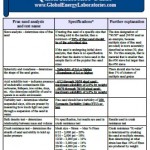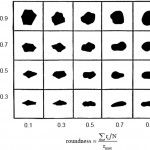Only sand that meets the American Petroleum Institute (API) standard specifications is likely to be used for frac sand.
Would you like a Quick Reference Guide for the Frac Sand specifications?

Here it is, a one page synopsis of the frac sand specs, ready for download in PDF format. Just enter your e-mail address.
Here is a quick definition of the frac sand specifications:
Sieve Testing Frac Sand Spec
Actually, if you are doing initial exploration to see if your sand can be used for hydraulic fracturing, there is no “hard and fast” specification.
Of course, you want a good percentage of your sand to fall out into the common frac sand sizes, but other than that, no hard and fast rule.
If you are already selling sand to be used for fracturing, at least 90% of the tested sample must fall out in your advertised size.
Computerized Particle Analysis (CPA)
Computerized particle analysis (CPA) has become an increasingly more common means determining frac sand size distribution and sphericity and roundness. It can be a very quick measurement of size and shape frac sand specs making it a great option for QA/QC at the load out of a frac sand mine.
Thousands to millions of particles can be run through the CPA machine. Size and shape properties of each passing frac sand particle are measured and the CPA machine outputs stats for the entire sample. While typical sphericity and roundness frac sand testing are subject to the human eye, computerized particle analysis can provide a non-biased, quantitative assessment of sphericity and roundness frac sand specs.
Sphericity and Roundness Testing Spec

The API recommends that all frac sand have sphericity of 0.6 or higher and a roundness of 0.6 or higher.
This sphericity and roundness test is performed by comparing the individual sand particles, viewed under a microscope, to a chart (Krumbein and Sloss).
Sphericity measures how close a particle is to a circle in its overall shape.
Roundness measures how smooth each particle’s corners are.
Acid Solubility Frac Test Spec
API recommends that for frac sand sized 6/12 through 30/50, that a maximum of 2.0% of the sand’s weight be soluble in acid.
API recommends that frac sand sized 40/70 through 70/140 have a maximum of 3.0% of the sand’s weight soluble in acid.
Turbidity Test Spec for Frac Sand
Turbidity results when clay or silt in the sand get suspended when mixed with water.
API recommends that turbidity of frac sand should be 250 FTU or less. FTU stands for “Formazin Turbidity Unit.”
FTU is a measure of how much light can pass through a suspension of the sand in water, mixed vigorously together and then allowed to stand for 5 minutes.
Bulk Density Testing
The bulk density of a sample is used to determine the mass of frac sand needed to fill a unit volume such as a fracture or storage tank as outlined in the API RP 19C.
Frac Sand Crush Resistance Test Specs
The crush resistance test is performed by crushing a sample of the sand under increasing pressure, and then holding at the target pressure.
After the sand is crushed, a sieve analysis is performed. The crushed sand particles that make their way into the pan are called “fines.”
The crush resistance k-value frac sand spec the highest stress level at which proppant generates no more than 10% fines. This is an important metric when determining if a new sand source could meet industry-accepted frac sand specs.
Additionally, the API has a spec for the maximum percentage of fines for each frac sand size.
| Mesh size of sand | Stress on sand (in PSI) | Suggested maximum fines (% by weight) |
| 6/12 | 2,000 | 20 |
| 8/16 | 2,000 | 18 |
| 12/20 | 3,000 | 16 |
| 16/30 | 3,000 | 14 |
| 20/40 | 4,000 | 14 |
| 30/50 | 4,000 | 10 |
| 40/70 | 5,000 | 8 |
| 70/140 | 5,000 | 6 |

